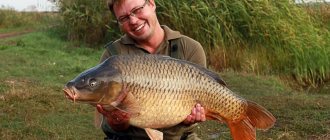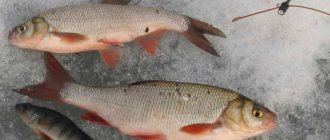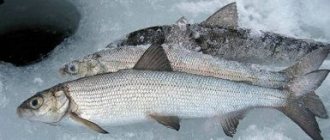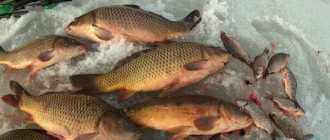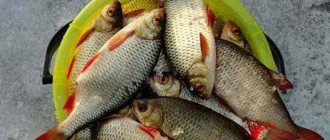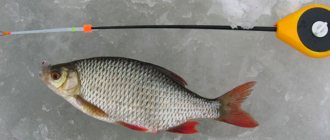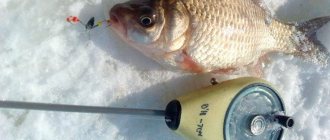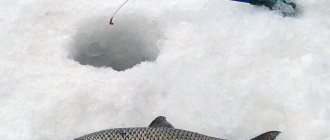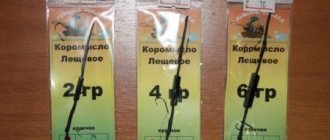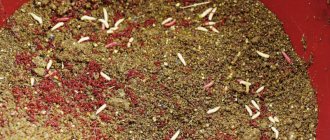Jig for carp
A jig for carp can sometimes show no less amazing results than float and feeder rigs.
In this case, there is no need to reel in the bait; it is enough to gently immerse it in the water. After this, a bite is usually likely to follow. It is easy to notice by the behavior of the guard. The best place to catch carp is in snags where the depth exceeds one meter. When the bait is immersed in water, the fish often finds itself with air bubbles, and if a bite does not occur within several minutes, it is better to deliver the bait to the place where the bubbles appeared.
Advantages of jig fishing in summer
The device of this bait is simple. This is a small hook, which is soldered with a fore-end into the tip of any heavy metal - tin, lead.
The differences between these winter and summer baits are determined by the life of the fish at different times of the year. In the summer, the fish are more active and the bite is more constant and faster. Even in the summer, fish come out that in winter do not show interest in the bait. For example, crucian carp and tench.
The standard summer jig has different sizes compared to the winter jig, as well as a different color. For example, it is used to catch crucian carp, resembling a dung fly pupa.
Fishing with a jig from the shore in the summer is a creative endeavor. At this time, the fish have enough food and the fisherman has to come up with different ways to move the bait in order for a bite to occur. This process is more productive in extreme heat, when the fish hides in thickets of grass.
Catching carp with a jig in summer with a side nod
Many jig fishermen note that fishing with a side nod in the middle of abundant thickets brings incredible excitement. The main thing is not to lose sight of the gatehouse. Holding the fishing rod in their hands, they concentrate all their attention on it. The nod, by the way, is a fairly important element of equipment, as we wrote about in the article “Summer jig tackle and nod can bring a big catch.”
You can buy it in a store, but often the factory parameters of the bite alarm do not suit the angler, and fishing with it in the summer becomes a big problem. It is not difficult to make it yourself from the most unusual materials - a clock spring, a plastic bottle and even a plastic clamp can easily be converted into a nod.
The length of the guard not only regulates its sensitivity, but also adjusts it to the weight of the bait. When a carp bites on a summer jig, its bites with a long nod are marked by neat broaches, longer in time, allowing the angler to react in time. The movements of the short bite indicator are chaotic, and they are transmitted to the bait, which is not very good.
If there is a targeted hunt for carp, it is more than ever worth making sure that it is not only light (you will have to hold it in your hands all day), but also very durable. A short line is not able to absorb the powerful jerks of a large specimen; the clutch on the reel, if it is inertialess, is tightened to capacity, and there is nothing to say about the wiring.
Such parameters are necessary because fishing is carried out among reeds and impassable grass, and in no case should the fish be given slack, otherwise it will drag the equipment into the thickets and easily break it. That is why the blank should easily lift a three-kilogram individual into the air. Naturally, the scaffolding must also be suitable for breaking.
Catching carp with a summer jig: tactics and technique
This type of fishing is an art. Carp bites are very careful, so it’s easy to miss. The guard barely rises and instantly returns to its original state, so a light bait is used, just so that the nod can feel it lowering onto the ground of the reservoir.
Let's look at why jigs for carp in summer are more effective than other types of equipment:
- at the first stage, the fish are attracted by the aroma of the bait;
- then he examines it with his pectoral fins and chin;
- if the carp is satisfied with everything, it carefully takes the bait and immediately pushes it out of its mouth, and so on several times;
- Having completed all these operations, the fish swallows the bait, if nothing suspicious has happened.
Now it’s worth imagining how possible it is to hook a carp if it constantly grabs the bait and immediately spits it out. This is why catching a large specimen on a float is so rare. And smaller specimens do not really pamper anglers. The float is not capable of transmitting the most delicate bite, unlike a nod.
There is no need to play with bait, this is not catching predatory fish, which we wrote about in the article “Catching grayling with a jig in the summer and making fly baits.” The nozzle smoothly sinks to the bottom, after which a bite occurs. A large specimen may become interested in what is on the hook after two to three minutes.
The hook should follow at the slightest movement of the bite indicator. Many anglers, noticing a barely noticeable lowering of the guard, patiently wait for a powerful blow, thinking that a small thing has come at the other end. This is absolutely not true, the carp just approaches and tries to try the proposed bait.
Carp fishing attachment
The most popular baits include potatoes, bread, boilies, earthworms, and peas. However, corn is firmly in first place. At the same time, it is used not only as a bait, but also as bait. And for it to be as attractive as possible, it must be prepared correctly.
First of all, the corn is soaked in water for a day. Once it has swollen enough, it is boiled for some time. This bait can attract fish from a long distance with its aroma. Some anglers prefer to fish for sour corn, for which they leave it in the water for 3-4 days.
To significantly enhance the diffused fragrance, various attractants are added to the grains. They do this when they are already swollen. Carps love highly softened grains, so it is worth boiling them longer. However, if you overdo it, you can end up with hominy instead of grains.
Catching carp with a summer jig (part 2)
I used a variety of bait for the jig, the most important thing was that it was as small as possible—about the size of a match head.
I used a variety of bait for the jig, the most important thing was that it was as small as possible—about the size of a match head. That is, the attachment only covers the hook tip. Baits used: potatoes, pearl barley, crayfish meat, gudgeon meat, small shells.
The fishing technique is as follows: no play is required from the jig at all. If you start playing with it, the carp won’t take it. The jig lowers smoothly and that’s it! As soon as it reaches the bottom, sometimes a bite follows - the nod nods. But large carp take about a little later (2-3 minutes). In this case, you need to keep the jig motionless at the bottom and be ready to hook. You need to hook at the slightest movement of the nod. Previously, I was waiting for a powerful bite and the slightest hesitation - I chalked it up to trifles, and these were carp bites!
The place where you fish with a jig should be deep and snaggy. You need to fish either from the bridge, or from the shore, or from the trees. The boat proved ineffective. A sufficient depth of 1 m. Even if a place is found with a hole nearby and snags near the shore, bites will only occur in certain places. Many people think that feeding a lot of bait is enough for successful fishing - lower the jig and it will take! Nothing like this! Carp, especially large ones, do not take bait. I don’t know why... I usually feed a certain point, for example, in a clean place 2 meters from a snag, I lower the jig on the edge of the bait or at the snag itself - the efficiency is amazing!
On the bait itself, I only took small carp - up to 2 kilos. While the jig is lowering, you need to look around - is the carp digging? Fish often give themselves away with bubbles. As soon as the jig comes to the bottom, pay attention to the nod, wait 5-10 minutes, remove the jig and lower it to the place where the bubbles are noticed. Bite zones can be limited to centimeters, a little to the side - it doesn’t take it. These zones are located near the tree trunks themselves or on the path of the carp along which it is accustomed to walk and graze. The carp will not take it anywhere else, no matter how tempting the bait is.
Sometimes this technique is very effective: if you find a tree trunk bare of aquatic plants and bark, going down slightly at an angle, then you can smoothly lower a jig along this trunk, constantly touching the snag. Carp sometimes attack the jig so hard that you can hear it hitting a tree trunk! Although it is difficult to force a carp to take it, it is possible.
Hooking is followed by such an important element as fishing. This process in an impassable cramp is akin to cowboys trying to stay on a bull. Thanks to my feisty stick, specimens weighing 3 kg simply dance on their tails, hanging in the air until they are caught.
A few words about the landing net and sucking.
The landing net should be as large and deep as possible - the carp spins so much that landing it is very problematic. A partner needs to do the trick; doing it on your own is very difficult. It’s another matter when the carp takes on a more impressive one. It’s useless to give recommendations here, one thing I can say is that more or less decent technique is developed only after your body has processed more than one bucket of adrenaline. At first I was simply shocked when there was a “locomotive” hanging on a hook, which, as if on rails, walked along the bottom without rising a centimeter. The result is predictable - the carp with a torn lip swam further. Later I developed this tactic.
Depending on the tightness of the place, I tighten the clutch tightly or loosely. I make a powerful hook in order to lift the confused carp to the surface. If, instead of the expected trophy, small fish up to a kilo are bitten, then it simply flies a meter out of the water. It is simply necessary to tear the carp off the bottom so that it loses its bearings, it is advisable to give it a breath of air. If the fish cannot be quickly “torn” from the bottom, the carp, having come to its senses, makes a powerful jerk towards the nearest snag - and you can say goodbye to it. If the carp is raised to the surface, then its first jerk is made at random, and you get an additional chance to get it out. Therefore, fishing must be forced. The carp needs to be pulled upward strongly, but not mindlessly.
On the first jerks, it is advisable to let the clutch, if space allows, release a little fishing line. Why is “mult” better than “meat grinder”? Yes, because you can adjust the stroke of the clutch by pressing the fishing line with your palm. In this type of fishing, there is simply no way to twist and adjust the clutch while fishing. If the carp nevertheless approaches the most impassable cramp, you have to clamp the line with your palm and hold on with all your strength. I have had cases where a carp almost pulled me into the water. After fishing, abrasions often formed and my hands hurt. A 5 m rod is a lot of leverage. And the carp pulls the tip with a force of 10 kg, it’s hard to keep it short without letting go.
Carp is a highly trainable fish. The third time you may not see a bite in the place where a lot of fish were caught the first time. It is necessary to change reservoirs whenever possible. One day I met the same jig fisherman who gave me my first fishing lesson. He complained that the fish stopped taking fish from his tree. I also noticed a decrease in carp activity more and more. The carp touched the fishing line without taking the jig into its mouth. I confess, it was a sinful thing that I decided to try to attach a tee and catch the carp. On one of the fishing trips I took the “Ovnerovsky” tee No. 4. I tried it with a jig - no luck, there were a couple of hours left. I took out a tee, tormented by remorse, tied it, put a pearl barley on each hook, not really believing it, I lowered it into the water... The nod pressed me so hard that it went right into my hand!
In a short period of time, 8 carp were caught on the chandelier (that’s what I called the tee with pearl barley), and everyone took the tee in their mouth. Why the carp took the tee like that - I don’t know! That jig fisherman complains to me about the bite, I lower the “chandelier” from his snag - a carp, then another one. He is at a loss!
Over the course of a couple of months while I was learning to fish, I caught a lot of carp weighing more than 2 kg, the largest weighing 5.5 - after catching it there was such an indescribable feeling! My godfather and I tried to film the whole process. A lot of “trains” have left. One carp took the chandelier and in a moment of confusion I brought it to the surface. The dimensions were terrible, the thickness of the back was almost as thick as a man’s torso, then he swam, reeling in the clutch clamped by 10-15 kg until he straightened all the hooks of the tee and got off. Very exciting fishing! Good luck!
Source: carpomaniya.com
Carp in winter using a jig - myth or reality
Fishing for carp in winter is a rare and exciting activity. Unfortunately, it begins to eat several times less; if in the summer the fish absorbed kilograms of food, then with the establishment of ice the count begins to count in grams. There is a widespread belief that in severe frosts the fish becomes completely passive, but this is often refuted by more successful anglers.
Any fish always bites well at the beginning of winter, and carp are no exception in this regard. It is in December that the maximum catches occur, especially if the winter period begins with mild weather marked by sunny days. But with the arrival of January, the carp becomes more passive.
It feeds briefly, occasionally making short forays. The time of such feeding is limited to half an hour a day, so it is useless to purposefully fish for carp. The situation worsens even more in February. Only at the end of the month, if weather conditions are favorable, can you catch these beautiful fish.
Jigs for crucian carp and crucian carp are more important in winter than float rigs with a hook and sinker. Inexperienced fishermen, counting on catching large specimens, tie a fairly thick monofilament, believing that the carp will not be spooked by the forest. Not quite the right decision, in winter the golden rule always applies: the thinner the forest, the greater the chances of being caught.
If you pay attention to the gear, you can see the similarity with the bream fishing rod, which we described in the article “What are good jigs for bream and what fishing technique should be used.” For example, a long and very sensitive nod is necessary, since the bites can be very different, including those similar to bream ones, when the guard is raised.
- The determining factor when fishing for carp is the bait. It is impossible to give clear recommendations here, since everything depends on the fishing conditions. In some reservoirs, fish prefer dough, corn or peas; in others, bites occur only when bloodworms or maggots are strung on the hook.
- Bait is also important, without which there may often be no bite. Here you can use both purchased mixtures and those you make yourself. The main thing is not to overfeed the fish, since in winter the amount of bait is required in much smaller quantities.
- The fish bite is very careful, so you need to focus all your attention on the nod. Fishing for a small specimen, weighing no more than a kilogram, does not cause much trouble, but jerking large specimens will require some skills from the angler.
Catching carp with a jig in the summer - carp in the winter with a jig
- Catching carp with a jig in summer with a side nod
- Catching carp with a summer jig: tactics and technique
- Carp fishing attachment
A jig for carp can sometimes show no less amazing results than float and feeder rigs. In this case, there is no need to reel in the bait; it is enough to gently immerse it in the water. After this, a bite is usually likely to follow. It is easy to notice by the behavior of the guard.
You may be interested in: Catching rotan with a jig in spring, summer and winter
The best place to catch carp is in snags where the depth exceeds one meter. When the bait is immersed in water, the fish often finds itself with air bubbles, and if a bite does not occur within several minutes, it is better to deliver the bait to the place where the bubbles appeared.
Catching carp with a jig in summer with a side nod
Many jig fishermen note that fishing with a side nod in the middle of abundant thickets brings incredible excitement. The main thing is not to lose sight of the gatehouse. Holding the fishing rod in their hands, they concentrate all their attention on it. The nod, by the way, is a fairly important element of equipment, as we wrote about in the article “Summer jig tackle and nod can bring a big catch.”
You may be interested in: Bolognese fishing from A to Z - floats for Bolognese fishing, equipment and tactics
You can buy it in a store, but often the factory parameters of the bite alarm do not suit the angler, and fishing with it in the summer becomes a big problem. It is not difficult to make it yourself from the most unusual materials - a clock spring, a plastic bottle and even a plastic clamp can easily be converted into a nod.
The length of the guard not only regulates its sensitivity, but also adjusts it to the weight of the bait. When a carp bites on a summer jig, its bites with a long nod are marked by neat broaches, longer in time, allowing the angler to react in time. The movements of the short bite indicator are chaotic, and they are transmitted to the bait, which is not very good.
If there is a targeted hunt for carp, it is more than ever worth making sure that it is not only light (you will have to hold it in your hands all day), but also very durable. A short line is not able to absorb the powerful jerks of a large specimen; the clutch on the reel, if it is inertialess, is tightened to capacity, and there is nothing to say about the wiring.
You may be interested in: Catching crucian carp on a track with a rubber shock absorber
Such parameters are necessary because fishing is carried out among reeds and impassable grass, and in no case should the fish be given slack, otherwise it will drag the equipment into the thickets and easily break it. That is why the blank should easily lift a three-kilogram individual into the air. Naturally, the scaffolding must also be suitable for breaking.
Catching carp with a summer jig: tactics and technique
This type of fishing is an art. Carp bites are very careful, so it’s easy to miss. The guard barely rises and instantly returns to its original state, so a light bait is used, just so that the nod can feel it lowering onto the ground of the reservoir.
Let's look at why jigs for carp in summer are more effective than other types of equipment:
- at the first stage, the fish are attracted by the aroma of the bait;
- then he examines it with his pectoral fins and chin;
- if the carp is satisfied with everything, it carefully takes the bait and immediately pushes it out of its mouth, and so on several times;
- Having completed all these operations, the fish swallows the bait, if nothing suspicious has happened.
Now it’s worth imagining how possible it is to hook a carp if it constantly grabs the bait and immediately spits it out. This is why catching a large specimen on a float is so rare. And smaller specimens do not really pamper anglers. The float is not capable of transmitting the most delicate bite, unlike a nod.
There is no need to play with bait, this is not catching predatory fish, which we wrote about in the article “Catching grayling with a jig in the summer and making fly baits.” The nozzle smoothly sinks to the bottom, after which a bite occurs. A large specimen may become interested in what is on the hook after two to three minutes.
The hook should follow at the slightest movement of the bite indicator. Many anglers, noticing a barely noticeable lowering of the guard, patiently wait for a powerful blow, thinking that a small thing has come at the other end. This is absolutely not true, the carp just approaches and tries to try the proposed bait.
Carp fishing attachment
The most popular baits include potatoes, bread, boilies, earthworms, and peas. However, corn is firmly in first place. At the same time, it is used not only as a bait, but also as bait. And for it to be as attractive as possible, it must be prepared correctly.
First of all, the corn is soaked in water for a day. Once it has swollen enough, it is boiled for some time. This bait can attract fish from a long distance with its aroma. Some anglers prefer to fish for sour corn, for which they leave it in the water for 3-4 days.
To significantly enhance the diffused fragrance, various attractants are added to the grains. They do this when they are already swollen. Carps love highly softened grains, so it is worth boiling them longer. However, if you overdo it, you can end up with hominy instead of grains.
Carp in winter using a jig - myth or reality
Fishing for carp in winter is a rare and exciting activity. Unfortunately, it begins to eat several times less; if in the summer the fish absorbed kilograms of food, then with the establishment of ice the count begins to count in grams. There is a widespread belief that in severe frosts the fish becomes completely passive, but this is often refuted by more successful anglers.
Any fish always bites well at the beginning of winter, and carp are no exception in this regard. It is in December that the maximum catches occur, especially if the winter period begins with mild weather marked by sunny days. But with the arrival of January, the carp becomes more passive.
It feeds briefly, occasionally making short forays. The time of such feeding is limited to half an hour a day, so it is useless to purposefully fish for carp. The situation worsens even more in February. Only at the end of the month, if weather conditions are favorable, can you catch these beautiful fish.
Jigs for crucian carp and crucian carp are more important in winter than float rigs with a hook and sinker. Inexperienced fishermen, counting on catching large specimens, tie a fairly thick monofilament, believing that the carp will not be spooked by the forest. Not quite the right decision, in winter the golden rule always applies: the thinner the forest, the greater the chances of being caught.
If you pay attention to the gear, you can see the similarity with the bream fishing rod, which we described in the article “What are good jigs for bream and what fishing technique should be used.” For example, a long and very sensitive nod is necessary, since the bites can be very different, including those similar to bream ones, when the guard is raised.
- The determining factor when fishing for carp is the bait. It is impossible to give clear recommendations here, since everything depends on the fishing conditions. In some reservoirs, fish prefer dough, corn or peas; in others, bites occur only when bloodworms or maggots are strung on the hook.
- Bait is also important, without which there may often be no bite. Here you can use both purchased mixtures and those you make yourself. The main thing is not to overfeed the fish, since in winter the amount of bait is required in much smaller quantities.
- The fish bite is very careful, so you need to focus all your attention on the nod. Fishing for a small specimen, weighing no more than a kilogram, does not cause much trouble, but jerking large specimens will require some skills from the angler.
When fishing for carp, extreme caution should be exercised. The hole must always be shaded with snow. A hook should be at hand, because if on the first ice a large specimen can still be somehow removed from the hole, then on thick spring ice it is much more difficult to do this.
How to make a jig for carp with your own hands
When choosing a jig, it is important to proceed from its simplest design. That is, you should not use baits hung with various tinsel - beads, threads, and so on. It has been noticed that drops and pellets made of tungsten, medium in size, are considered the most catchy.
It is believed that in winter, carp take baits painted to resemble summer baits, the main ones being corn, dough, potatoes, and pearl barley. Accordingly, yellow, gold-plated, silver and even white colors should predominate. In this case, such a color should be present only on one side, while the other part is preferably black or gray.
Winter and summer jigs for carp can be made with your own hands in a variety of ways. One of the simplest is sawing, when using a jigsaw or metal file, a blank is made from copper, silver, brass and steel. After sanding, a hook is soldered to the body.
If you take thin strips of metal, you can roll them into any shape. A hook is inserted into the hole, after which the body is soldered. Depending on the amount of solder, the mass of the jig will vary. The second option is to wrap several layers of copper wire around the hook and apply solder.
Lead blanks can be forged with a small hammer. The most difficult method is casting. Here it takes a lot of time to make the mold, which in most cases is made of plaster. In addition to making the body of the jig yourself, it is modernized based on the purchased one, changing the shape and painting.
Source
How to make a jig for carp with your own hands
When choosing a jig, it is important to proceed from its simplest design. That is, you should not use baits hung with various tinsel - beads, threads, and so on. It has been noticed that drops and pellets made of tungsten, medium in size, are considered the most catchy.
It is believed that in winter, carp take baits painted to resemble summer baits, the main ones being corn, dough, potatoes, and pearl barley. Accordingly, yellow, gold-plated, silver and even white colors should predominate. In this case, such a color should be present only on one side, while the other part is preferably black or gray.
Winter and summer jigs for carp can be made with your own hands in a variety of ways. One of the simplest is sawing, when using a jigsaw or metal file, a blank is made from copper, silver, brass and steel. After sanding, a hook is soldered to the body.
If you take thin strips of metal, you can roll them into any shape. A hook is inserted into the hole, after which the body is soldered. Depending on the amount of solder, the mass of the jig will vary. The second option is to wrap several layers of copper wire around the hook and apply solder.
Lead blanks can be forged with a small hammer. The most difficult method is casting. Here it takes a lot of time to make the mold, which in most cases is made of plaster. In addition to making the body of the jig yourself, it is modernized based on the purchased one, changing the shape and painting.
How to make a jig for summer fishing with your own hands?
Jigs for summer fishing can be made at home. Some methods have been developed:
sawing is the easiest way. Various rods, tubes, pieces of copper, steel, and bronze are cut into pieces. Then the hook is soldered and various finishing treatments are performed;- soldering - a shape is cut out of copper or bronze plates and a hook is soldered. Such good jigs can be obtained by filling copper spirals with lead;
- casting - the beginning of work begins with the preparation of a jig mold for pouring molten metal. For this, chalk, plaster, and brick are used. After filling the mold, wait for the finished bait to cool and then begin processing it.
When casting and soldering, personal protective equipment must be used.
Habitats of carp in winter
A common belief is that carp go deep into the cold and bite little in winter. Experienced fishermen refute this, since they often managed to catch a good catch in the winter months. Places rich in such living creatures may be underwater fields with dead algae and depressions on the bottom. A large concentration of food that attracts fish is concentrated under the coastal trees hanging over the water.
Fishermen often choose the warmest, non-freezing sections of the river near power plants. In this case, to catch carp in winter you will need additional gear and boat equipment. Close location of underwater keys is also preferable. The oxygen regime is of great importance, so you need to choose places with good water aeration, for example, the mouths of streams and rivers. It is better to search in the summer.
What and how to catch carp in winter
Many people believe that catching crucian carp and crucian carp in winter using a float is ineffective, but this is a mistaken opinion. Winter carp fishing captured on video by a fisherman proves that it is possible, although you need to have some experience.
Snaps
First of all, we prepare the fishing line and float rod. If you use a short fishing rod for carp, there will be no shock absorption and then you will need a stretchable fishing line. Braided line doesn't stretch, so it won't work.
It is better to purchase special winter equipment. The diameter of the monofilament fishing line when fishing should be no more than 0.3 mm. In mild frosts, fish are caught using a sliding float. But the classic option is preferable, when the float goes 2 - 3 cm into the water.
Some fishermen go after carp in winter with a spinner, a feeder and even a jig, but the jig still remains the most popular tackle. Beginners can make the mistake of immediately counting on a large catch and believing that a thick fishing line will not scare away the fish. This can work on artificial ponds where there is an abundance of animals that will grab any bait. Beginning fishermen should understand that the main rule when fishing in natural bodies of water is thin tackle.
Therefore, to catch specimens weighing up to 2 kg, a fishing line with a diameter of 0.1 - 0.12 mm is sufficient. A close examination of the gear for winter fishing for individual fish species reveals their similarity. The main feature of the fishing rods is the long nod. You can make a jig yourself. For this you will need “pellets”, “bugs” or “oatmeal”.
Groundbaits
Catching carp in autumn is easier than in winter, but bait must be used at any time of the year. Some fishermen prefer the factory version, others prepare the mixtures themselves, following their individual recipes. Try not to overfeed the fish. In winter, less food is required than in warm periods, and under the ice the movement of the inhabitants of reservoirs occurs more slowly.
Baits and lures
An important condition when using a jig on carp is the nozzle, which is selected depending on the conditions. In some rivers and lakes it is caught well on peas, corn or dough, in others it catches well on bark beetles, maggots or bloodworms. Therefore, before deciding on a bait, familiarize yourself with the taste preferences of the inhabitants in a particular reservoir.
Bait for carp fishing should also attract with an appetizing smell. It is better if it is easily digestible. Tiger nuts, chickpeas, and corn are not suitable for this purpose. It’s a good idea to use a bait such as a boilie for bait. Vegetable boilies and boilies with a high protein content will appeal to carp. Fishermen are experimenting with “sandwiches” that combine different types of bait that are interesting to fish.
Preparing gear for jig fishing in summer
Choosing a rod. To fish in summer using this method, you don’t need any special gear. All configurations are suitable for summer fishing. Knowing the basics of collecting gear, any fisherman can assemble it himself.
When fishing, a light action rod is required. This includes both fly fishing rods and spinning rods with small test indicators. All this is necessary so that the angler sets the game for this bait and feels it well.
Carbon fiber and composite fishing rods are just right for this type of fishing. To use from the shore and from a boat, different lengths of the rod are required, for example, from a boat no more than 4 meters, from the shore you can use 8 meters.
At different depths, the equipment changes; a rod with guides or a clean fly tackle is used.
Choosing a fishing line. Fishing with a jig in the summer involves the use of monofilament fishing line. It is advisable to select the diameter according to the size of the fish and the weight of the bait used. You also need to take into account that with a thicker fishing line there will be no play and the sensitivity of the entire tackle will decrease. But even a thin fishing line will not withstand the jerks of the fish.
Does it make sense to catch carp with a jig?
Fans of winter fishing know the secrets of how to fish with the jig used for fishing when fishing for carp in winter. You won’t find jigs designed specifically for this fish, so you can take any other baits with a diameter of up to 5 mm. They are selected empirically.
Jigs for winter carp fishing
The most popular among experienced fishermen are crystallik, pellet and uralka. As a tackle, the winter jig has proven itself well. This is an affordable, effective and simple tool used by adherents of winter fishing, which is good for carp.
The best jig for carp
Effective devices used in catching it are metal pellets. It is advisable that they have a loop for fastening, so the fishing line will not be cut off. After attaching the bloodworm, the jig is lowered into the hole, at a distance of about 5 cm from the bottom.
Catching carp in winter with a jig
This version of the tackle is also suitable for fishing for carp or carp in winter; in addition, the nodding fishing rod has good information content and sensitivity.
Tackle for catching carp or carp in winter using a jig
Fans of winter fishing know the secrets of how to fish with the jig used for fishing when fishing for carp in winter. You won’t find jigs designed specifically for this fish, so you can take any other baits with a diameter of up to 5 mm. They are selected empirically.
Jigs for winter carp fishing
The most popular among experienced fishermen are crystallik, pellet and uralka. As a tackle, the winter jig has proven itself well. This is an affordable, effective and simple tool used by adherents of winter fishing, which is good for carp.
The best jig for carp
Effective devices used in catching it are metal pellets. It is advisable that they have a loop for fastening, so the fishing line will not be cut off. After attaching the bloodworm, the jig is lowered into the hole, at a distance of about 5 cm from the bottom.
Many novice fishermen make a very big mistake when they use gear designed to catch carp weighing more than two kilograms. When fishing for carp, the main fishing rule applies - the thinner the tackle, the better.
Some anglers say that thick line does not deter carp. But, most likely, this only happens in artificial ponds, in which the abundance of fish simply makes them grab everything that falls into the water.
If you look a little more closely at the gear for catching carp with a jig, you will notice that they are very similar to the gear for catching bream in winter. The main thing is a long enough nod.
Carp bites can occur in different ways, but most often it, like bream, raises a nod. There are no special jigs for carp, so there is no need to look for them on the shelves of fishing stores, just buy or make large oats or pellets yourself.
The key factor in catching carp with a jig is the bait. This is an individual matter and you need to choose bait depending on the fishing conditions.
In some reservoirs, carp catch well on corn, peas or dough, while in others it is better to catch it on bloodworms or maggots. So before choosing bait, answer yourself the question of what the carp bite on in your pond.
Don’t forget to experiment, because very often you have to catch fish with so-called sandwiches (a combination of different baits on a hook).
The carp bite on a jig is very sluggish and sometimes difficult to notice. But if you still notice it and hook the fish in time, then the most interesting part begins - fishing.
Pulling out a carp weighing less than a kilogram from a hole will not be difficult, but fishing for trophy specimens is exciting and requires the fisherman to have certain skills. The first jerks of the carp are considered the most powerful, after which you need to slowly lead it to the hole, the main thing is not to fuss and not to rush.
Catching carp with a jig in winter is not a very simple task, which requires certain knowledge from the fisherman. Do not forget that it is best to darken the hole with snow. Bagorik needs to be prepared in advance. Because if it is not there, then the fisherman will have to undergo an unpleasant procedure - stick his hand into the hole and pull out the fish. On thin ice it is quite simple, but on thick ice it is completely different.
Jigs for carp
Carp are caught in winter using regular hooks, but it is best to use jigs. You won’t find special jigs for carp fishing on store shelves, but don’t be upset. Any nozzles with a large diameter, about 5 mm, will do. The best and catchiest jigs are considered to be Uralka, pellet and crystal. But it depends on your pond.
Retrieving a jig when fishing for carp
The best retrieve is considered to be weak shaking of the jig at the very bottom. Don’t forget about pauses, sometimes they need to be done for a few seconds, and sometimes even for 5 minutes. Tapping on the bottom attracts most fish, but carp are an exception. You need to place the jig on the bottom smoothly and carefully. The jig should be raised from the bottom no more than 20 centimeters, or simply moved slightly.
How to make a jig for carp with your own hands
When biting, the fish can behave aggressively, so the jig must be reliable. To make it yourself, you will need to purchase materials: a lead stick and hooks that are suitable for catching a particular type of fish. The tools you need are wire cutters, “ducklings,” a soldering iron, solder, and soldering acid.
To make a “pellet” jig, we take a lead stick and a hook that is most suitable for catching carp in your pond. After removing the ball with pliers, it should be cleaned, for which you can use any knife. It is convenient to do this with a stationery knife. It is necessary to clean the ball of burrs in order to prevent damage to the fishing line when fishing with a jig. We take the finished ball, solder, a heated soldering iron, rosin and soldering acid.
DIY jigs for carp
Catching carp in winter with a jig.
have had experience in catching carp and crucian carp with a jig in winter since 1994. The maximum catch in wild ponds reached 15 kilograms per day - two carp (3 kg and 700 grams) and the rest - two hundred grams of crucian carp. But in 1997 I got a job. Her specificity made it possible to frequently visit fish farms. So at the end of 1997 I made my first attempt. December. Frost around ten. The two of us saw one ruff bite and that was it. In February the whole pond was riddled with zero. I caught one perch in the shallows. The watchman, a dry little man, stated the fact that no one fishes here in winter, and I’m wasting my time. To which I replied that I would certainly try again a little later, since should still be caught with a jig in the winter
At the beginning of March, a thaw set in and everything began to flow. The boss arranges a fishing trip for Wednesday. I wake up - it’s raining, but there’s nowhere to go, - fishing is ordered - I have to go. I take a second set of clothes, an umbrella, jump into the UAZ, and here I am on the pond. I drilled along the dam at different depths, drilled the mouth of the adjacent ravine, and fed all the holes with two buckets of cake. As a result, per day in the area where the ravine flows into the pond, where water was rapidly flowing from the forested hills, 3 carp and 3 crucian carp, two hundred grams each.
I come home happy - the pond is printed. I'm going there again on Sunday, hoping to have a blast. Overboard minus one. There is soft, non-creaking snow on the ice. Light south wind, cloudy. The weather is perfect. I drill into the area of the coastline in the ravine and the adjacent 20-30 meters. Depth from one and a half to two and a half meters. There are about fifteen holes every 10-15 meters. I'm feeding. Suddenly the watchman runs and forbids me to catch, since there was no call from the director today. Having made five unsuccessful runs in several holes, I leave the place prepared for fishing. It’s half a kilometer to the car, I walk up, and word by word, I start an hour-long conversation with the watchman who chased me away about fishing stories. He listened with interest, but I was in no hurry, and besides, it turned out that he knew my father well. I don’t know what ultimately influenced his decision, but it was this: “You are such an interesting, avid fisherman. On my own responsibility, I allow you to fish until five o’clock.” Which pleasantly surprised me, and I grabbed a box, a bag of cake and an empty sugar bag for fish, just in case, and went to the feeding place. I approach the last hole 20 meters from the beginning of the ravine. I put a bloodworm on the jig hook, a nod signals that the bait touches the bottom. I carry out a slow low-frequency rise, followed by a shudder of a nod, followed by a lightning-fast hook and a two-hundred-gram crucian carp flies out of the hole onto the ice with a characteristic splash. Again the jig touches the bottom, the nod is slightly bent, and after a second it smoothly rises - hooking - cutting through, it looks like a carp. I make a second attempt, again raising the nod, hooking, the rod whip bends as much as possible. I quickly loosen the reel with a screw, throw the fishing rod to the side, the 0.15 fishing line quickly slides between my thumb and forefinger, rushing into the cold abyss of water. This is carp. Heartbeats shake the whole body, as always. It takes my breath away. These are the happy moments that we, fishermen, patiently wait for and are ready to do anything for. Meanwhile, the force of resistance weakens and the right hand drops the first meter of fishing line onto the soft velvety snow. The left one at this moment slowly goes up, again waiting for help from the right one. So, either handing over the fishing line or choosing it back, the process of saving the fishing line from breaking occurs. As a result, after about seven minutes of such a struggle, my hook pulls out of the hole into the white sparkling snow a three-kilogram yellow beauty with burning bright red fins. There is a beginning. Ten minutes of fishing - crucian carp and crucian carp.
All. The hole needs to rest - I move to another one, located on the central line of the ravine, about ten meters from the shoreline to the middle of the pond. I lower the jig with a bunch of bloodworms, barely signaling that the jig has touched the bottom, the nod lazily rises... After five minutes of the process described above, the hook again drags out the carp, whose weight is two kilograms.
The heart gradually calms down again. I decide to change the fishing rod with a thicker fishing line - 0.2 (yellow seven-year-old Japanese that has not lost its quality).
I move on to the first hole - five crucian carp and a kilogram carp. I come back - 2.5 kg of carp.
Now I’m moving along the center line of the ravine to the level of the coastline. A similar rise of the nod follows, the line goes out and goes out, I note the time - 11.20. The fishing line has stopped, but it does not move, it is kept in one position + - 20 cm. Here it dawns on me that the carp at this moment is moving in a circle with a radius equal to the length of the fishing line. In our case, about ten meters. Every two or three minutes the radius decreases and the fish gradually gives up, circle by circle. But suddenly, at 11.40, out of the blue, there was a gathering.
I start checking all the other holes, each of which contains either crucian carp or carp up to a kilogram. There are no more large ones. Therefore, my intuition pushes me to check the hole where the derailment took place.
Again, twenty minutes of struggle and already in the hole the weak pike hook fails and the jig flies into my forehead, and the carp slowly sinks and leaves. Annoyance and disappointment overcome me, but on the third attempt I still caught a carp weighing 3,600 from this hole. And the resistance was like that of a five-kilogram one.
So I frolicked, not noticing the time. And at three o'clock the watchman came and, seeing the amount of fish - half a bag, broke his promise and suggested ending it there.
Having given the watchman a bottle of vodka and a dozen crucian carp for the pleasure, I, tired and satisfied, returned home to the monotonous hum of my UAZ. Fishing for carp in winter was a success.
Secrets of winter carp fishing
Successful fishing depends on thoughtful tactics. First of all, it is advisable to study the bottom topography. This is done using an echo sounder. If there is no device, then focus on the coastline, which is a continuation of the bottom. In the morning you should fish at greater depths, moving to the shallows during the day, as the fish swim there to feast on bloodworm larvae and small fish.
Don't stay in one place for too long. If there is a carp where you made the hole, a nod will definitely indicate its presence with a smooth swing, followed by the first jerks. The technology for wiring the bait is simple. Carp is a bottom-dwelling fish, so its attention can be attracted by “devil” strikes on the bottom. If you put a maggot on a hook, then a seductive smell will also come from the bait.
When the bite is low, it is worth taking small-mass “devils,” and when large specimens are highly active, choose a larger bait, thereby attracting picky carp. If there is no bite, then play in another horizon, not forgetting about the pause. The bait for lead and soldered jigs can be bloodworms and pearl barley. If circumstances go well, you don’t have to wait long for a bite.
Great winter fishing for monster carp
We prepared fishing rods and tackle - 0.25 mm fishing line, a bright float, a simple but catchy jig-shot and a bloodworm.
I planted several bloodworms at once - the carp really loves a bunch of such red “worm-larvae”. And into the hole...
A few minutes later the first fish appeared in the hole - a carp weighing 2 kilos.
But at another moment, a giant fish broke the fishing line, and another fisherman straightened his jig. That's how fish are here!
People began to arrive, so they decided to change the place away from the “bunch” of fishermen, and explore and find fish.
In a new place it bit and immediately dragged the float away - something heavy got caught on the jig...
And the fight began! Who wins, carp or fisherman?
5-6 minutes of fishing for a huge carp lasted what felt like an eternity. The giant carp resisted for a long time and did not want to get into the hole.
When the fish got tired, they managed to pull it onto the ice...
It turned out to be a carp weighing 9 kilograms - what a monster!
Then another fisherman, a neighbor in the hole, caught a good carp weighing 4 kilos.
You can see winter fishing for huge carp for yourself:
The carp continued to be caught. But how much do we need? One such “boar” is enough. Wonderful fishing! Adrenaline, as they say, “full of pants” and emotions - the end!
NHNCH (No tail, no scales) to everyone! Follow my new publications - it will be even more interesting!
Additional entries
1 comment in “Winter fishing for huge carp that bend the jig and break the gear”
It is useless to catch carp in winter. Like crucian carp, it buries itself in the silt and rises only when the ice melts. However, even in the spring it bites poorly, despite the winter fast. The reason for this is young reeds, the juicy shoots of which the carp prefers to any food at this time. Later, when the reed stems harden, the carp begin to feed on slugs attached to the reed stems, dragonfly larvae and the dragonflies themselves, which they swallow very deftly, jumping out of the water. This is a sign of his active bite - it’s time to adjust the gear. It is not difficult to determine the places where carp gather: by their chomping in the reeds and bubbles rising from the bottom onto the water surface. This fish is schooling, not shy, accustomed to noise and to the boat. The beginning of carp fishing in central Russia is mid-May. Then it spawns, for this the water must warm up to 17-18 degrees. Spawning ends in the second half of June. From now until the end of August is the time for the most active carp biting. In May it is better to catch it with a worm or a bunch of bloodworms. In summer - for all vegetable baits, including slightly undercooked potatoes, as well as for maggots. But the most reliable way is to use oatmeal porridge mixed with cake, the smell of which carp is very partial to. In September he still continues to peck, but not so actively. It is best to catch it at this time using crayfish meat, as well as a crawling worm or a bunch of bloodworms. Fishing is more successful with bait. You can feed them with mixed feed, crackers, pieces of bread, any steamed grains, scattering them in fishing areas. Accustomed to additional nutrition, the carp rushes to the food without any caution and chooses a pleasant-smelling delicacy - rolls of oatmeal porridge with oil cake.
Add a comment Cancel reply
Something new
Winter fishing 2021 on zherlitsy: interesting footage of what happens to pike and live bait under the ice
The female share of the mysterious peoples “Mansi” and “Khanty” - one day in the life in the Siberian taiga
An ancient cunning way of catching fish among the peoples of the North - the Khanty call it “botat”
Summer fishing: catching carp with a jig
I am an avid fisherman with experience. I had the opportunity to fish in different places and at different times. But in any business, from time to time you want to change something. Fishing is no exception. I thought that I had caught a lot of fish of all kinds in my time, but there had not been any large carp among my trophies yet. And I decided that it was time to fill this gap.
At that time I had practically no experience in carp fishing, so I did a lot on a whim.
I decided to fish with float rods and use boiled potatoes and porridge for bait. The first fishing trip brought nothing but disappointments. Didn't catch anything at all! And then very rarely it was possible to catch carp - not the kind I saw in my dreams, of course, but at least some. Sometimes it seemed to me that the carp was just laughing at me - it jumped out on the floats and around, but still did not fall for my bait.
Near the place where I usually fished, several times I saw one fisherman who just managed to remove carp from the hook. I decided to try my luck in the same place. He arrived, fed him, and began to wait. It doesn't bite, that's all. And then that same fisherman arrives, sits down a little behind me, throws a handful of porridge into the water and begins to unwind the fishing rod with a nod. Well, I think, eccentric, who is catching on this! I was about to open my mouth to tell him that the carp wasn’t taking it, and at that moment he pulled out the first carp. And then it started: one after another, a kilogram or more. After the tenth carp, my nerves gave way and I began to reel in my fishing rods. But this fishing trip literally made me “sick” with the jig.
